4 Workshop 4: Practical Time Management (Professional Development Seminar)
Lauryn Lim; Jack Miranda; Tiana Bressan; John Donald; and Technical Editor: Yasamin Jahani Kia
 As engineering students, we have one of the highest workloads, all on top of other commitments such as extra curriculars, sports, or design projects. What is missing is the focus on self – putting time aside for yourself and your values to keep you grounded.
As engineering students, we have one of the highest workloads, all on top of other commitments such as extra curriculars, sports, or design projects. What is missing is the focus on self – putting time aside for yourself and your values to keep you grounded.
WHAT IS TIME MANAGEMENT? WHY IS IT IMPORTANT?
How do we achieve this?
- Notion – an online planning tool.
- Time Management Matrix – a tool to find out your priorities and manage tasks.
- Reflection and planning for continuous improvement.
NOTION
Notion is an all in one digital workspace that can be used to organize your schedule, plan goals, and make weekly plans. Notion allows for flexibility and allows everyone to adjust to their personal styles of learning. As long as you are familiar with the basics of Notion, you can use it in any way that you wish.
To learn more about the many features of Notion and to make your own account, you can visit this link: https://www.notion.so.
TIME MANAGEMENT MATRIX
What is a Time Management Matrix and why is it important?
A Time Management Matrix is a visual management tool that prioritizes your tasks according to their importance and urgency. This is one way to go through organizing time, but it is important to note that everyone has different styles of learning.
The Time Management Matrix allows you to become proactive instead of reactive with your time and allows you to focus your time on truly meaningful productivity instead of simply checking off a to-do list. The matrix helps you question whether what you are doing everyday is what you want to do or need to do. This tool can be used on a day to day, weekly, or monthly basis based on your preference.
Here is a sample Time Management Matrix:
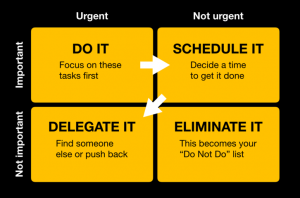
THE 4 QUADRANTS
QUADRANT 1: IMPORTANT & URGENT
Quadrant 1, also known as “putting out fires”, includes tasks that are important and urgent and need to be focused on first. This can include crises, pressing problems, and deadline-driven projects. Some examples of such tasks can include emails, tests and assignments, or meetings. It is considered best practice to aim towards keeping this quadrant as empty as possible and reflecting on what needs to be done first on daily, weekly, or monthly basis.
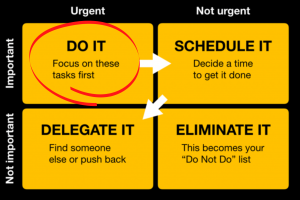
QUADRANT 2: IMPORTANT & NOT URGENT
Quadrant 2, also known as the “sweet spot”, is at the heart of effective personal management and helps to prevent burnout by not finishing all tasks at the last moment. This quadrant includes tasks that are important but not urgent and it is considered best practice to prioritize this quadrant. Some examples include exercising, relationship building, studying for a test coming up, or specific daily goals.
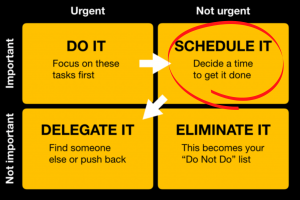
QUADRANT 3: NOT IMPORTANT BUT URGENT
Quadrant 3, also known as “unfortunately unavoidable”, includes tasks that are urgent but not important such as interruptions, favors for others, or some calls and meetings. The urgency of these tasks is based on the priorities and expectations of other people. It is considered best practice to only focus on this quadrant in the short term and to focus on your personal values to determine whether the task is important or not. The tasks in this quadrant can also be delegated to others or delayed to a later time.
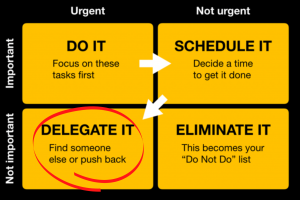
QUADRANT 4: NOT IMPORTANT & NOT URGENT
Quadrant 4, also known as “wasting your time”, includes tasks that are neither important nor urgent such as trivial activities, distractions, and impulsive pleasant activities such as spending excess time on social media or binge watching a show on Netflix. It is inevitable to have some time wasters but they are reminders of what not do and it is considered best practice to eliminate them.

MACRO-LEVEL: SUPPORTING YOUR LIFE GOALS
The Time Management Matrix can also be applied in a larger scale. Some examples can include passing courses, fitness/health goals, or overall studying goals. Think of the matrix at the macro-level – what is urgent and important? Quantifying your priorities relative to importance and time in advance will help you to be in the right quadrant on a day to day basis.
TIME MANAGEMENT MATRIX: KEY TAKEAWAYS
There are some key takeaways that we wanted to highlight:
- Identify your time wasters and adopt strategies for reducing them.
- Clarify and prioritize your personal objectives and goals.
PUTTING IT INTO ACTION: PLANNING
It is important to schedule meaningful time to manage your tasks and self-evaluate.
Here are some steps that you can take to achieve this:
Step 1: Build your quadrants and know your activities.
Step 2: Plan your days.
Step 3: Reflect on what worked and what did not in the previous week.
Here are two resources that can help you achieve your time management goals:
- College Schedule Maker: https://www.coursicle.com/college-schedule-maker/
- Timely: https://memory.ai/timely-blog/time-management-techniques
This is an example schedule made through using the College Schedule Maker:
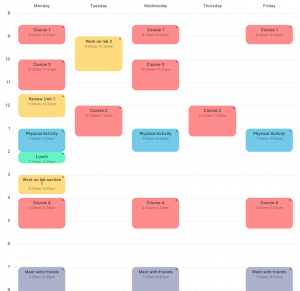
PUTTING IT INTO ACTION: REFLECTING
It is important to put time aside in this process to reflect and ask yourself what worked and what did not as reflecting helps keep us on track. If your time management strategy was successful, it is important to note the reasons for the success and know ways in which you can repeat this strategy in the future. On the other hand, if your time management strategy was not successful, you should ask yourself what steps you can take to improve on this for the coming days, weeks, or months.
WORKSHOP KEY TAKEAWAYS
Time management is beyond accomplishing tasks, it is also about doing what you like, reducing stress, and making better decisions. As we discussed, there are many tools for success such as Notion, the time management matrix, and weekly planning and you can use any that you prefer based on what works for you.
RESOURCES
- The 7 Habits of Highly Effective People by Stephen R. Covey
- Notion Help: https://www.youtube.com/watch?v=j30bABy2BHA

